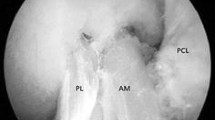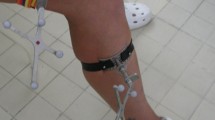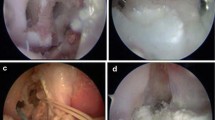Abstract
The purpose of this study was to evaluate tibiofemoral kinematics after double-bundle anterior cruciate ligament (ACL) reconstructions and compare them with those of successful single-bundle reconstructions and contralateral normal knees using open MR images. We obtained MR images based on the flexion angle without weight-bearing, from 20 patients with successful unilateral single-bundle (10 patients) and double-bundle (10 patients) ACL reconstructions with tibialis anterior allografts and a minimum 1-year follow-up. The MR images of the contralateral uninjured knees were used as normal controls. Sagittal images of the mid-medial and mid-lateral sections of the tibiofemoral compartments were used to measure the translation of the femoral condyles relative to the tibia. The mean translations of the medial femoral condyles on the tibial plateaus during knee joint motion showed no significant differences among normal, single-bundle, and double-bundle ACL reconstructed knees (all p>0.05). The mean translations of the lateral femoral condyles showed a significant difference between normal and single-bundle reconstructed knees, or between single-bundle and double-bundle reconstructed knees (p<0.05). However, there was no significant difference between normal and double-bundle reconstructed knees (p=0.220). These findings suggest that double-bundle ACL reconstruction restores normal kinematic tibiofemoral motion better than single-bundle reconstruction.
Résumé
Le but de cette étude était d’évaluer, par les images de résonnance magnétique, la cinématique tibio-fémorale après reconstruction du ligament croisé antérieur par double tunnel et de la comparer avec celle obtenue après réussite des reconstructions à un seul tunnel et celle du genou normal controlatéral. Nous avons étudié des images basées sur l’angle de flexion en décharge chez 20 patients après reconstruction par allogreffe tibiale antérieure suivis au moins un an : 10 avec succés de la reconstruction par un seul tunnel et 10 avec reconstruction par un double tunnel. Les images du genou controlatéral non traumatisé servaient de contrôle. Des images sagittales de la partie moyenne des compartiments fémoro-tibiaux permettaient la mesure de la translation des condyles fémoraux par rapport au tibia. La translation du condyle interne pendant la flexion du genou n’était pas différente entre le genou normal et la reconstruction par simple ou double tunnel (p>0,05). La translation du condyle externe était significativement différente entre le genou normal et la reconstruction par simple tunnel et entre les reconstructions par simple et double tunnel (p<0,05). Cependant il n’y avait pas de différence entre le genou normal et la reconstruction par double tunnel (p=0,220). Ces résultats suggèrent que la reconstruction du croisé antérieur par double tunnel restore mieux la cinématique du genou que la reconstruction par simple tunnel.



Similar content being viewed by others
References
Adachi N, Ochi M, Uchio Y, Iwasa J, Kuriwaka M, Ito Y (2004) Reconstruction of the anterior cruciate ligament. Single- versus double-bundle multistranded hamstring tendons. J Bone Joint Surg 86–B:515–520
Bellier G, Christel P, Colombet P, Djian P, Franceschi JP, Sbihi A (2004) Double-stranded hamstring graft for anterior cruciate ligament reconstruction. Arthroscopy 20:890–894
Bonnin M, Carret JP, Dimnet J, Dejour H (1996) The weight-bearing knee after anterior cruciate ligament rupture. An in vitro biomechanical study. Knee Surg Sports Traumatol Arthrosc 3:245–251
Daniel DM, Stone ML, Dobson BE, Fithian DC, Rossman DJ, Kaufman KR (1994) Fate of the ACL-injured patient: a prospective outcome study. Am J Sports Med 22:632–644
Dienst M, Burks RT, Greis PE (2002) Anatomy and biomechanics of the anterior cruciate ligament. Orthop Clin North Am 33:605–620
Gabriel MT, Wong EK, Woo SL, Yagi M, Debski RE (2004) Distribution of in situ forces in the anterior cruciate ligament in response to rotatory loads. J Orthop Res 22:85–89
Hamada M, Shino K, Horibe S, Mitsuoka T, Miyama T, Shiozaki Y, Mae T (2001) Single- versus bi-socket anterior cruciate ligament reconstruction using autogenous multiple-stranded hamstring tendons with endoButton femoral fixation: A prospective study. Arthroscopy 17:801–807
Harter RA, Osternig LR, Singer KM, James SL, Larson RL, Jones DC (1988) Long-term evaluation of knee stability and function following surgical reconstruction for anterior cruciate ligament insufficiency. Am J Sports Med 16:434–443
Hill PF, Vedi V, Williams A, Iwaki H, Pinskerova V, Freeman MA (2000) Tibiofemoral movement 2: the loaded and unloaded living knee studied by MRI. J Bone Joint Surg 82-B:1196–1198
Iwaki H, Pinskerova V, Freeman MA (2000) Tibiofemoral movement 1: the shapes and relative movements of the femur and tibia in the unloaded cadaver knee. J Bone Joint Surg 82-B:1189–1195
Kaplan MJ, Howe JG, Fleming B, Johnson RJ, Jarvinen M (1991) Anterior cruciate ligament reconstruction using quadriceps patellar tendon graft. Part II. A specific sport review. Am J Sports Med 19:458–462
Laxdal G, Kartus J, Hansson L, Heidvall M, Ejerhed L, Karlsson J (2005) A prospective randomized comparison of bone-patellar tendon-bone and hamstring grafts for anterior cruciate ligament reconstruction. Arthroscopy 21:34–42
Logan M, Dunstan E, Robinson J, Williams A, Gedroyc W, Freeman M (2004) Tibiofemoral kinematics of the anterior cruciate ligament (ACL)-deficient weightbearing, living knee employing vertical access open "interventional" multiple resonance imaging. Am J Sports Med 32:720–726
Logan MC, Williams A, Lavelle J, Gedroyc W, Freeman M (2004) Tibiofemoral kinematics following successful anterior cruciate ligament reconstruction using dynamic multiple resonance imaging. Am J Sports Med 32:984–992
Mannel H, Marin F, Claes L, Durselen L (2004) Anterior cruciate ligament rupture translates the axes of motion within the knee. Clin Biomech 19:130–135
Marcacci M, Molgora AP, Zaffagnini S, Vascellari A, Iacono F, Presti ML (2003) Anatomic double-bundle anterior cruciate ligament reconstruction with hamstrings. Arthroscopy 19:540–546
Muneta T, Koga H, Morito T, Yagishita K, Sekiya I (2006) A retrospective study of the midterm outcome of two-bundle anterior cruciate ligament reconstruction using quadrupled semitendinosus tendon in comparison with one-bundle reconstruction. Arthroscopy 22:252–258
Muneta T, Sekiya I, Yagishita K, Ogiuchi T, Yamamoto H, Shinomiya K (1999) Two-bundle reconstruction of the anterior cruciate ligament using semitendinosus tendon with Endobuttons: Operative technique and preliminary results. Arthroscopy 15:618–624
Sernert N, Kartus J, Kohler K, Stener S, Larsson J, Eriksson BI, Karlsson J (1999) Analysis of subjective, objective and functional examination tests after anterior cruciate ligament reconstruction. A follow-up of 527 patients. Knee Surg Sports Traumatol Arthrosc 7:160–165
Tashman S, Collon D, Anderson K, Kolowich P, Anderst W (2004) Abnormal rotational knee motion during running after anterior cruciate ligament reconstruction. Am J Sports Med 32:975–983
Woo SL, Kanamori A, Zeminski J, Yagi M, Papageorgiou C, Fu FH (2002) The effectiveness of reconstruction of the anterior cruciate ligament with hamstrings and patellar tendon. A cadaveric study comparing anterior tibial and rotational loads. J Bone Joint Surg 84-A:907–914
Yagi M, Wong EK, Kanamori A, Debski RE, Fu FH, Woo SL (2002) Biomechanical analysis of an anatomic anterior cruciate ligament reconstruction. Am J Sports Med 30:660–666
Yasuda K, Kondo E, Ichiyama H, Kitamura N, Tanabe Y, Tohyama H, Minami A (2004) Anatomic reconstruction of the anteromedial and posterolateral bundles of the anterior cruciate ligament using hamstring tendon grafts. Arthroscopy 20:1015–1025
Yasuda K, Kondo E, Ichiyama H, Tanabe Y, Tohyama H (2006) Clinical evaluation of anatomic double-bundle anterior cruciate ligament reconstruction procedure using hamstring tendon grafts: comparisons among 3 different procedures. Arthroscopy 22:240–251
Author information
Authors and Affiliations
Corresponding author
Rights and permissions
About this article
Cite this article
Seon, J.K., Song, E.K., Bae, B.H. et al. Kinematic study following double-bundle, anterior cruciate ligament reconstruction. International Orthopaedics (SICO 31, 623–628 (2007). https://doi.org/10.1007/s00264-006-0244-2
Received:
Accepted:
Published:
Issue Date:
DOI: https://doi.org/10.1007/s00264-006-0244-2




